
Residual heat from volcanic activity may be causing a river of ice to flow in Greenland, a new study indicates. Geologists have found that the region directly above a stream of relatively fast moving ice is thinner than a simple model of glacier change would predict. This observation, described in a report published today in the journal Science, may help researchers pin down the contribution ice sheets have made to sea level changes.
Glaciers are built up from layers of fused snow that spr

Most climate change research has focused on gradual changes, such as the processes by which emissions of greenhouse gases lead to warming of the planet.
But new evidence shows that periods of gradual change in Earth’s past were punctuated by episodes of abrupt change, including temperature changes of about 10 degrees Celsius, or 18 degrees Fahrenheit, in only a decade in some places.
Severe floods and droughts also marked periods of abrupt change.
A new report from the Nati

American Geophysical Society Meeting, San Francisco, December 2001
Pressure system secrets could help long range forecasts.
The rise in levels of greenhouse gases has halted an oscillation of air pressures over the Arctic, bringing warmer, wetter winters to Northern Europe, Siberia and Alaska. The shift could get worse with increasing CO2 emissions, delegates heard this week at the American Geophysical Union meeting in San Francisco, California.
The trend is unlikel

In 1998, Paul F. Hoffman and Daniel P. Schrag at Harvard University put forth a chilling description of earth’s climate some 650 million years ago. Their theory, dubbed snowball earth, held that between 750 million and 580 million years ago, ice repeatedly enveloped our planet, coating the seas from pole to pole and killing off early life almost completely. During the past few years, the idea has stirred up a great deal of debate. And new data published in the December issue of Geology only furt

Mount Vesuvius, the volcano most famous for blanketing the towns of Pompei and Herculaneum with lava and debris in 79 A.D., may be sitting atop a reservoir of magma that covers more than 400 square kilometers, a new study suggests. The finding, reported in the current issue of the journal Science by a group of Italian and French scientists, may lead to more accurate monitoring of the area surrounding the volcano.
Building on previous work that suggested the presence of a magma zone underne
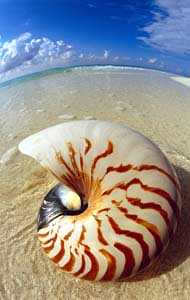
Water trapped for millions of years gives a glimpse of oceans’ turbulent past.
Drops of sea water entombed within salt crystals millions of years ago are giving researchers a glimpse of ancient oceans. The water, trapped during evaporation, reveals that the seas have seen large chemical changes during their history.
“The consensus had been that sea-water chemistry hadn’t changed that much over the past 600 million years,” says geochemist Juske Horita of Oak Ridge National La
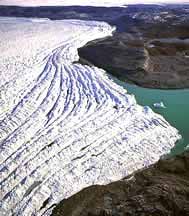
Half a century of thinning ice leaves Greenland’s future looking wet.
There is new evidence that the Greenland ice pack is in retreat. The finding may be a foretaste of still more rapid melting, and in turn, rising sea levels.
The ice sheet over northwest Greenland has thinned by 10-15 cm a year over the past 40 years, two scientists calculate 1 . The trend indicates “a significant long-term thinning”, says one, Niels Reeh, of the Technical University of

With a weather monitoring network a new model could predict coastal floods in Bangladesh. A new model should help forecast the massive floods to which the northern coast of Bangladesh is prone 1 . In principle, the model can predict the heights and arrival times of the huge waves that cyclones cause, and so could improve the planning of sea defences. The effectiveness of the model will depend on the availability of accurate, timely and detailed meteorological data, ca
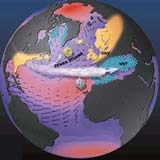
Ozone miniholes over the North Atlantic follow the unsteady pulse of climate fluctuations.
Recurring fluctuations in the North Atlantic climate are punching miniholes in the ozone layer, exposing Scandinavia and northern Europe to higher levels of ultraviolet radiation than normal, say two climatologists.
Seesawing air pressure over Greenland and the subtropical north Atlantic Ocean stirs the atmosphere and wafts ozone-depleted air towards populated high-latitude regions in
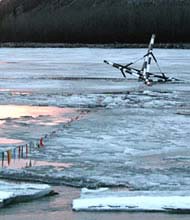
The smart money is on global warming.
An Alaskan sweepstake has become a record of global warming. The competition to predict when ice will melt reveals that, on average, the thaw comes more than five days earlier now than it did 84 years ago 1 .
In the winter of 1917, railway engineers working in Nenana, Alaska whiled away the long winter nights by erecting a wooden tripod on the frozen Tenana River and placing bets on the exact moment in spring when it would
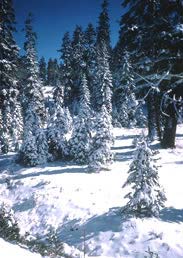
Meterologists look up for long-range forecasts.
Looking high into the atmosphere now might tell us whether we’re in for a white Christmas. Unusual stratospheric conditions herald changes in winter weather in the Northern Hemisphere up to two months later, say US researchers 1 .
The finding won’t let your weather forecaster warn you to wrap up warm two months hence, but it may be a valuable addition to meteorologists’ toolkits. “The effect works on average, bu